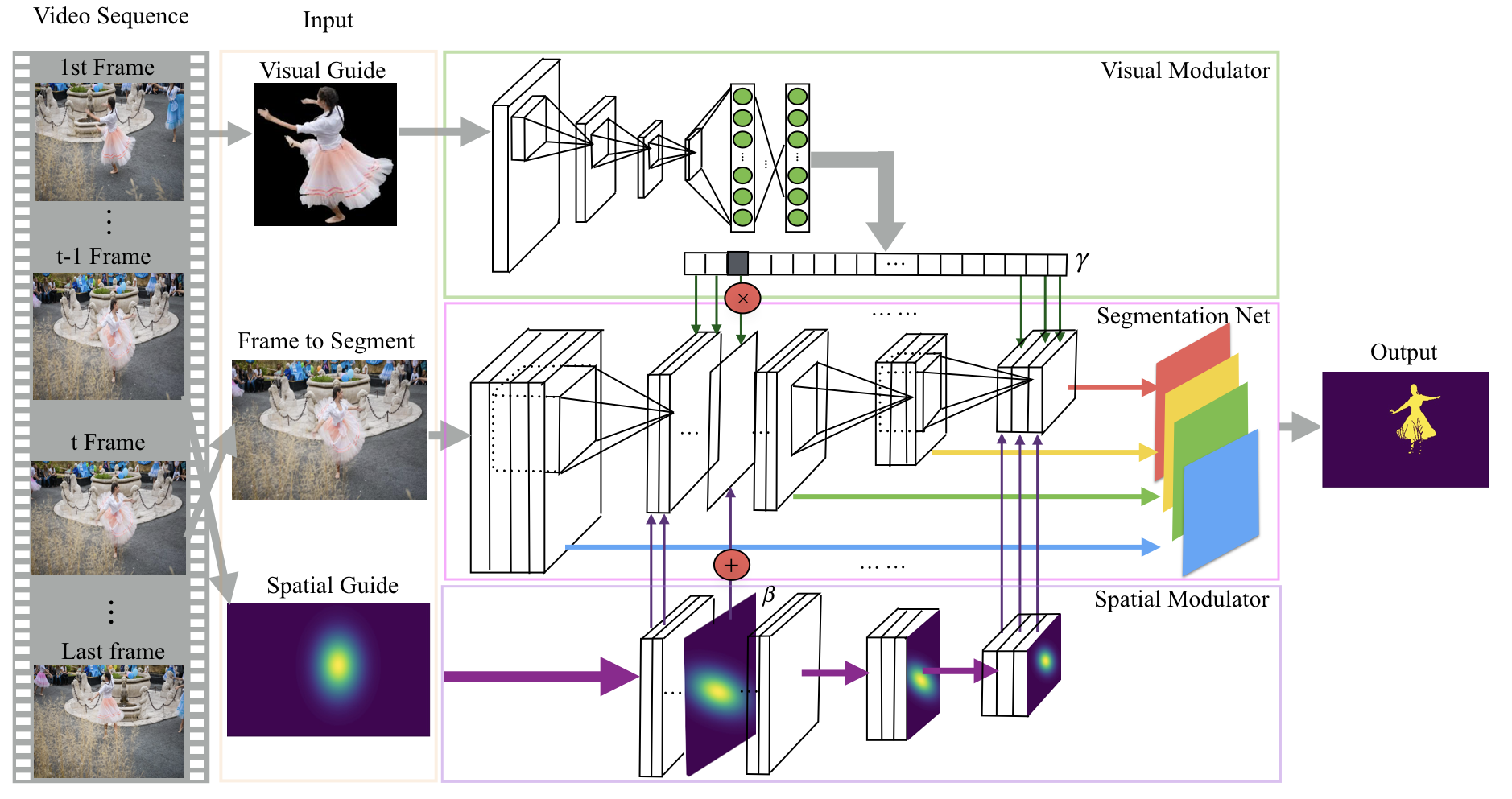This repo is the released code of one-shot modulation network described in the CVPR 2018 paper:
@article{ Yang2018osmn,
author = {Linjie Yang and Yanran Wang and Xuehan Xiong and Jianchao Yang and Aggelos K. Katsaggelos},
title = {Efficient Video Object Segmentation via Network Modulation},
journal = {CVPR},
year = {2018}
}
In this work, we propose to use a meta neural network named modulator to manipulate the intermediate layers of the segmentation network given the appearance of the object in the first frame. Our method only takes 140ms/frame for inference on DAVIS dataset.
-
Clone the repository
git clone https://github.com/linjieyangsc/video_seg.git
-
Install if necessary the required dependencies:
- Python 2.7
- Tensorflow r1.0 or higher (
pip install tensorflow-gpu) along with standard dependencies - Densecrf by Philipp Krähenbühl and Vladlen Koltun
- Other python dependencies: PIL (Pillow version), numpy, scipy
- Download MS-COCO 2017 dataset from here.
- Download the VGG 16 model trained on Imagenet from the TF model zoo from here.
- Place the vgg_16.ckpt file inside
models/. - Run
python osmn_coco_pretrain.py --data_path DATA_PATH --model_save_path MODEL_SAVE_PATH --gpu_id GPU_ID --training_iters 200000to train the model with a default learning rate 1e-5. After it finishes, runpython osmn_coco_pretrain.py --data_path DATA_PATH --model_save_path MODEL_SAVE_PATH --gpu_id GPU_ID --training_iters 300000 --learning_rate 1e-6to further train it with a decreased learning rate. Be sure to keepMODEL_SAVE_PATHthe same as in the first step to restore from existing checkpoint. For reference to other arguments, please check them by runningpython osmn_coco_pretrain.py -h.
- Download DAVIS 2017 dataset from here.
- Preprocess the dataset by running
python preprocessing/preprocess_davis.py DATA_DIR. - To finetune and evaluate the model on DAVIS 2017 as stated in the paper, run
python osmn_train_eval.py --data_path DATA_PATH --whole_model_path WHOLE_MODEL_PATH --result_path RESULT_PATH --model_save_path MODEL_SAVE_PATH_FT --gpu_id GPU_ID --batch_size 4 --fix_bn --randomize_guide --training_iters 50000 --learning_rate 1e-6. HereWHOLE_MODEL_PATHshould be the path to the model saved by Stage 1 training. Other arguments can be seen by runningpython osmn_train_eval.py -h. After it finishes, the prediction result on DAVIS 2017 will be saved intoRESULT_PATH.
- The trained model can be further improved by online one-shot finetuning on specific video sequences. Run the following command to finetune the model on either DAVIS 2016 or 2017.
python osmn_online_finetune.py --whole_model_path WHOLE_MODEL_PATH --result_path RESULT_PATH --model_save_path MODEL_SAVE_PATH_OL --gpu_id GPU_ID --batch_size 1 --training_iters 100 --data_version [2016/2017]
- To evaluate either Stage 1 or 2 model on DAVIS. Please run the following command.
python osmn_train_eval.py --data_path DATA_PATH --whole_model_path WHOLE_MODEL_PATH --result_path RESULT_PATH --only_testing --data_version [2016/2017] --gpu_id GPU_ID [--save_score] [--use_full_res]
--save_score need to be set while testing on DAVIS 2017, which is required to combined score maps of different objects for final prediction. --use_full_res is to use full resolution images for inference, which can be beneficial when visual guide is small.
Then run the following command to get the mIU score.
python davis_eval.py DATA_PATH RESULT_PATH DATASET_VERSION DATASET_SPLIT
- To evaluate the model on Youtube Objects. First download the dataset, then preprocess the dataset by running
python preprocessing/preprocess_youtube.py DATA_DIR. Then evaluate the model.
python osmn_eval_youtube.py --data_path DATA_PATH --whole_model_path WHOLE_MODEL_PATH --result_path RESULT_PATH --gpu_id GPU_ID
Then use the following command to get the mIU score.
python youtube_eval.py DATA_PATH RESULT_PATH
- We release official model for both Stage 1 and 2, which can be downloaded from here. The Stage 1 model obtains mIU 72.2 on DAVIS 2016 and 52.5 on DAVIS 2017. The Stage 2 model obtains mIU 74.0 on DAVIS 2016.
YoutubeVOS (https://youtube-vos.org/) is currently the largest video object segmentation dataset. To train and evaluate the model on YoutubeVOS, run python osmn_train_eval_ytvos.py --data_path DATA_PATH --result_path RESULT_PATH --model_save_path MODEL_SAVE_PATH --gpu_id GPU_ID --batch_size BATCH_SIZE --randomize_guide --training_iters 200000. After it finishes, further train the model with a decreased learning rate 1e-6 for 100k iterations.
To evaluate the model, run the following command to generate results for each object.
python osmn_train_eval_ytvos.py --data_path DATA_PATH --whole_model_path WHOLE_MODEL_PATH --result_path RESULT_PATH --only_testing --gpu_id GPU_ID --save_score
Then use the script ytvos_merge_result.py to merge objects in the same video:
python ytvos_merge_result.py DATA_PATH PRED_PATH OUTPUT_PATH DATA_SPLIT
Finally upload the results to Codalab website of the ECCV challenge.
If you have any questions regarding the repo, please send email to Linjie Yang (yljatthu@gmail.com).
